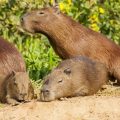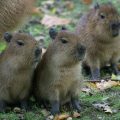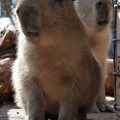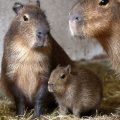Table of Contents
Capybaras are large rodents belonging to the genus of Hydrochoerus; where the only existing member is the Hydrochoerus isthmius better known as “lesser capybaras.” Native to South America; capybaras are the largest rodents in the world and actually related to guinea pigs and rock cavies; and distant cousins relatives of agouti, coypu and chinchillas. They’re commonly found in the dense forests and savannas, and live close to water sources. They’re found in large groups of around 10 to 20; but some groups can merge and make up to 100 individuals; making them highly social animals. Though commonly hunted for meat and for breeding as pets, they’re not listed as endangered animals. In this article, you’ll also learn what they feed on, and capybaras habitat.
Etymology
The scientific name (Hydrochoerus) comes from the Greek word hydor which means water, and choiros, meaning pig or hog; which translates to water hog/pig. Its common name however, is derived from the Tupi (language native to Brazil) word ka’apiûara; which is a complex joining of words kaá (meaning leaf), píi (meaning slender), ú (to eat) and ara (which is a suffix for agent nouns). The agglutination means “one who eats slender leaves”, which can be easily understood as “grass eater.”
Distribution and Habitat
As said earlier, capybaras habitat are native in South America, with huge population in Brazil and Venezuela; and some parts of northern Argentina, select parts of Columbia, Amazonian Ecuador, Bolivia, Peru, and Uruguay.
Capybaras habitat anywhere with good concentration of grass, such as open planes and tropical forests; but always near freshwater sources. They live close to water for different reasons; such as swimming away from predators, wallowing, and of course, drinking. These animals also forage and rest in dry lands.
Capybaras live in marshy, swampy, and grassy areas near rivers, lakes, streams, and ponds. They usually prefer muddy rivers packed with aquatic grasses and they need extensive amount of low water times.
Diet and Predation
As herbivores, capybaras mainly graze on grass and aquatic plants, tree barks and fruits. They’re however, quite selective on their feed, and they usually simply disregard other animals around them. During dry season where fewer varieties of plants are available, they eat various types of grass. During wet season on the other hand, they can switch to more abundant food.
The plants they eat during summer also often lose their nutritional value on winter; which is why they skip on them at that time.
They can also eat their own feces, which is a good source of bacterial gut flora, an essential aspect for their digestion; as cellulose forms their usual diet, and allow maximum absorption of vitamins and protein from their food.
Like cows and goats, they also regurgitate their food to eat again.
Capybaras jaw hinges are uniquely designed; they are not perpendicular, which means they have to chew their food back and forth; which is very different from most mammals which chews side to side. And as with most rodents, they’re equipped with two large front teeth which they use for grinding grass. They’re designed to grow continuously to compensate the wear and tear of constant eating of coarse grass.






 Author and long-time animal lover. Sharing knowledge on pet care through experience and the written word.
Author and long-time animal lover. Sharing knowledge on pet care through experience and the written word.